|
|
| |
|
|
| |
|
|
|
|
| |
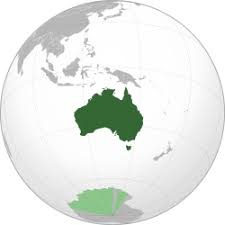 |
| Map showing location
of Australia. |
Australia
Australia, formally the Commonwealth of Australia, is a
country and sovereign state in the southern hemisphere,
located in Oceania. Its capital city is Canberra, and
its largest city is Sydney.
Australia is the sixth biggest country in the world by
land area, and is part of the Oceanic and Australasian
regions. Australia, New Zealand, New Guinea and other
islands on the Australian tectonic plate are together
called Australasia, which is one of the world's great
ecozones. When other Pacific islands are included with
Australasia, it is called Oceania.
25 million people live in Australia, and about 85% of
them live near the east coast. The country is divided up
into six states and two territories, and more than half
of Australia's population lives in and around the cities
of Sydney, Melbourne, Brisbane, Perth and Adelaide.
Australia is known for its mining (coal, iron, gold,
diamonds and crystals), its production of wool, and as
the world's largest producer of bauxite. Its emblem is a
flower called the Golden Wattle. |
|
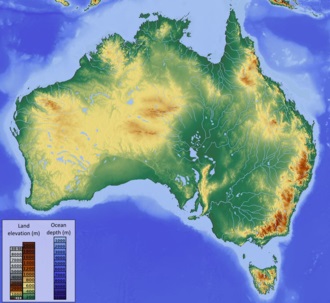 |
| Topographic map of
Australia. Dark green represents the lowest
elevation and dark brown the highest. |
Geography
General characteristics
Australia's landmass of 7,617,930 square kilometres
(2,941,300 sq mi) is on the Indo-Australian Plate.
Surrounded by the Indian and Pacific oceans, it is
separated from Asia by the Arafura and Timor seas, with
the Coral Sea lying off the Queensland coast, and the
Tasman Sea lying between Australia and New Zealand. The
world's smallest continent and sixth largest country by
total area, Australia—owing to its size and isolation—is
often dubbed the "island continent", and is sometimes
considered the world's largest island. Australia has
34,218 kilometres (21,262 mi) of coastline (excluding
all offshore islands), and claims an extensive Exclusive
Economic Zone of 8,148,250 square kilometres (3,146,060
sq mi). This exclusive economic zone does not include
the Australian Antarctic Territory. Apart from Macquarie
Island, Australia lies between latitudes 9° and 44°S,
and longitudes 112° and 154°E.
The Great Barrier Reef, the world's largest coral reef,
lies a short distance off the north-east coast and
extends for over 2,000 kilometres (1,240 mi). Mount
Augustus, claimed to be the world's largest monolith, is
located in Western Australia. At 2,228 metres (7,310
ft), Mount Kosciuszko on the Great Dividing Range is the
highest mountain on the Australian mainland. Even taller
are Mawson Peak (at 2,745 metres or 9,006 feet), on the
remote Australian territory of Heard Island, and, in the
Australian Antarctic Territory, Mount McClintock and
Mount Menzies, at 3,492 metres (11,457 ft) and 3,355
metres (11,007 ft) respectively. |
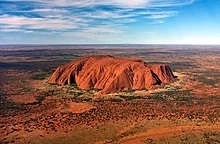 |
| Uluru in the
semi-arid region of Central Australia. |
Australia's size gives it a wide variety of landscapes,
with tropical rainforests in the north-east, mountain
ranges in the south-east, south-west and east, and dry
desert in the centre. It is the flattest continent, with
the oldest and least fertile soils; desert or semi-arid
land commonly known as the outback makes up by far the
largest portion of land. Australia is the driest
inhabited continent; its annual rainfall averaged over
continental area is less than 500 mm. The population
density, 2.8 inhabitants per square kilometre, is among
the lowest in the world, although a large proportion of
the population lives along the temperate south-eastern
coastline.
Eastern Australia is marked by the Great Dividing Range,
which runs parallel to the coast of Queensland, New
South Wales and much of Victoria. The name is not
strictly accurate, because parts of the range consist of
low hills, and the highlands are typically no more than
1,600 metres (5,249 ft) in height. The coastal uplands
and a belt of Brigalow grasslands lie between the coast
and the mountains, while inland of the dividing range
are large areas of grassland. These include the western
plains of New South Wales, and the Einasleigh Uplands,
Barkly Tableland, and Mulga Lands of inland Queensland.
The northernmost point of the east coast is the
tropical-rainforested Cape York Peninsula.
The landscapes of the Top End and the Gulf Country—with
their tropical climate—include forest, woodland,
wetland, grassland, rainforest and desert. At the
north-west corner of the continent are the sandstone
cliffs and gorges of The Kimberley, and below that the
Pilbara. To the south of these and inland, lie more
areas of grassland: the Ord Victoria Plain and the
Western Australian Mulga shrublands. At the heart of the
country are the uplands of central Australia. Prominent
features of the centre and south include Uluru (also
known as Ayers Rock), the famous sandstone monolith, and
the inland Simpson, Tirari and Sturt Stony, Gibson,
Great Sandy, Tanami, and Great Victoria deserts, with
the famous Nullarbor Plain on the southern coast. |
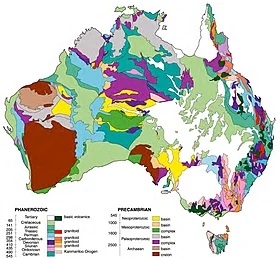 |
| Basic geological
regions of Australia, by age. |
Geology
Lying on the Indo-Australian Plate, the mainland of
Australia is the lowest and most primordial landmass on
Earth with a relatively stable geological history. The
landmass includes virtually all known rock types and
from all geological time periods spanning over 3.8
billion years of the Earth's history. The Pilbara Craton
is one of only two pristine Archaean 3.6–2.7 Ga (billion
years ago) crusts identified on the Earth.
Having been part of all major supercontinents, the
Australian continent began to form after the breakup of
Gondwana in the Permian, with the separation of the
continental landmass from the African continent and
Indian subcontinent. It separated from Antarctica over a
prolonged period beginning in the Permian and continuing
through to the Cretaceous. When the last glacial period
ended in about 10,000 BC, rising sea levels formed Bass
Strait, separating Tasmania from the mainland. Then
between about 8,000 and 6,500 BC, the lowlands in the
north were flooded by the sea, separating New Guinea,
the Aru Islands, and the mainland of Australia. The
Australian continent is moving toward Eurasia at the
rate of 6 to 7 centimetres a year.
The Australian mainland's continental crust, excluding
the thinned margins, has an average thickness of 38 km,
with a range in thickness from 24 km to 59 km.
Australia's geology can be divided into several main
sections, showcasing that the continent grew from west
to east: the Archaean cratonic shields found mostly in
the west, Proterozoic fold belts in the centre and
Phanerozoic sedimentary basins, metamorphic and igneous
rocks in the east.
The Australian mainland and Tasmania are situated in the
middle of the tectonic plate and have no active
volcanoes, but due to passing over the East Australia
hotspot, recent volcanism has occurred during the
Holocene, in the Newer Volcanics Province of western
Victoria and southeastern South Australia. Volcanism
also occurs in the island of New Guinea (considered
geologically as part of the Australian continent), and
in the Australian external territory of Heard Island and
McDonald Islands. Seismic activity in the Australian
mainland and Tasmania is also low, with the greatest
number of fatalities having occurred in the 1989
Newcastle earthquake. |
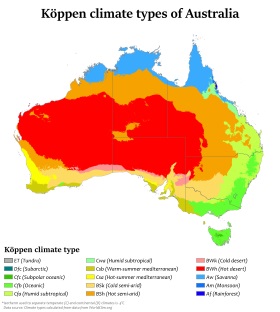 |
| Köppen climate types
of Australia. |
Climate
The climate of Australia is significantly influenced by
ocean currents, including the Indian Ocean Dipole and
the El Niño–Southern Oscillation, which is correlated
with periodic drought, and the seasonal tropical
low-pressure system that produces cyclones in northern
Australia. These factors cause rainfall to vary markedly
from year to year. Much of the northern part of the
country has a tropical, predominantly summer-rainfall
(monsoon). The south-west corner of the country has a
Mediterranean climate. The south-east ranges from
oceanic (Tasmania and coastal Victoria) to humid
subtropical (upper half of New South Wales), with the
highlands featuring alpine and subpolar oceanic
climates. The interior is arid to semi-arid.
Driven by climate change, average temperatures have
risen more than 1°C since 1960. Associated changes in
rainfall patterns and climate extremes exacerbate
existing issues such as drought and bushfires. 2019 was
Australia's warmest recorded year, and the 2019–20
bushfire season was the country's worst on record.
Australia's greenhouse gas emissions per capita are
among the highest in the world.
Water restrictions are frequently in place in many
regions and cities of Australia in response to chronic
shortages due to urban population increases and
localised drought. Throughout much of the continent,
major flooding regularly follows extended periods of
drought, flushing out inland river systems, overflowing
dams and inundating large inland flood plains, as
occurred throughout Eastern Australia in 2010, 2011 and
2012 after the 2000s Australian drought. |
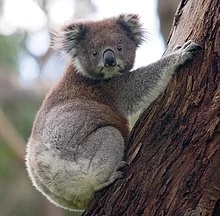 |
| The koala and the
eucalyptus form an iconic Australian pair. |
Biodiversity
Although most of Australia is semi-arid or desert, it
includes a diverse range of habitats from alpine heaths
to tropical rainforests, and is recognised as a
megadiverse country. Fungi typify that diversity; an
estimated 250,000 species—of which only 5% have been
described—occur in Australia. Because of the continent's
great age, extremely variable weather patterns, and
long-term geographic isolation, much of Australia's
biota is unique. About 85% of flowering plants, 84% of
mammals, more than 45% of birds, and 89% of in-shore,
temperate-zone fish are endemic. Australia has the
greatest number of reptiles of any country, with 755
species. Besides Antarctica, Australia is the only
continent that developed without feline species. Feral
cats may have been introduced in the 17th century by
Dutch shipwrecks, and later in the 18th century by
European settlers. They are now considered a major
factor in the decline and extinction of many vulnerable
and endangered native species.
Australian forests are mostly made up of evergreen
species, particularly eucalyptus trees in the less arid
regions; wattles replace them as the dominant species in
drier regions and deserts. Among well-known Australian
animals are the monotremes (the platypus and echidna); a
host of marsupials, including the kangaroo, koala, and
wombat, and birds such as the emu and the kookaburra.
Australia is home to many dangerous animals including
some of the most venomous snakes in the world. The dingo
was introduced by Austronesian people who traded with
Indigenous Australians around 3000 BCE. Many animal and
plant species became extinct soon after first human
settlement, including the Australian megafauna; others
have disappeared since European settlement, among them
the thylacine.
Many of Australia's ecoregions, and the species within
those regions, are threatened by human activities and
introduced animal, chromistan, fungal and plant species.
All these factors have led to Australia's having the
highest mammal extinction rate of any country in the
world. The federal Environment Protection and
Biodiversity Conservation Act 1999 is the legal
framework for the protection of threatened species.
Numerous protected areas have been created under the
National Strategy for the Conservation of Australia's
Biological Diversity to protect and preserve unique
ecosystems; 65 wetlands are listed under the Ramsar
Convention, and 16 natural World Heritage Sites have
been established. Australia was ranked 3rd out of 178
countries in the world on the 2014 Environmental
Performance Index. |
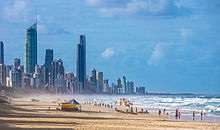 |
| Australia has one of
the world's most highly urbanised populations
with the majority living in metropolitan cities
on the coast, such as Gold Coast, Queensland. |
Regions and cities
Australia has six states, two major mainland
territories, and other minor territories. The states are
New South Wales, Queensland, South Australia, Tasmania,
Victoria, and Western Australia. The two major mainland
territories are the Northern Territory and the
Australian Capital Territory (ACT).
In 2013 according to world bank Australia had just over
23.13 million people. Most Australians live in cities
along the coast, such as Sydney, Melbourne, Brisbane,
Perth, Darwin, Hobart and Adelaide. The largest inland
city is Canberra, which is also the nation's capital.
The largest city is Sydney.
Australia is a very big country, but much of the land is
very dry, and the middle of the continent is mostly
desert. Only the areas around the east, west and south
coast have enough rain and a suitable climate (not too
hot) for many farms and cities. |
|
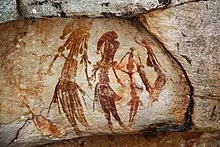 |
| Aboriginal rock art
in the Kimberley region of Western Australia. |
History
Aboriginal people
The Australian Aboriginal people arrived in Australia
about 50,000 years ago or even earlier. Until the
arrival of British settlers in 1788, the Aboriginal
people lived by hunting and gathering food from the
land. They lived in all sorts of climates and managed
the land in different ways. An example of Aboriginal
land management was the Cumberland Plain where Sydney is
now. Every few years the Aboriginal people would burn
the grass and small trees. This meant that a lot of
grass grew back, but not many big trees. Kangaroos like
to live on grassy plains, but not in forests. The
kangaroos that lived on the plain were a good food
supply for the Aboriginal people. Sometimes, Aborigines
would name a person after an animal, and they could not
eat that animal to help level out the food population.
Aboriginal people did not usually build houses, except
huts of grass, leaves and bark. They did not usually
build walls or fences, and there were no horses, cows or
sheep in Australia that needed to be kept in pens. The
only Aboriginal buildings that are known are fish-traps
made from stones piled up in the river, and the remains
of a few stone huts in Victoria and Tasmania. The
Aboriginal people did not use metal or make pottery or
use bows and arrows or weave cloth. In some parts of
Australia the people used sharp flaked-stone spearheads,
but most Aboriginal spears were made of sharply pointed
wood. Australia has a lot of trees that have very hard
wood that was good for spear making. The boomerang was
used in some areas for sport and for hunting.
The Aboriginal people did not think that the land
belonged to them. They believed that they had grown from
the land, so it was like their mother, and they belonged
to the land. |
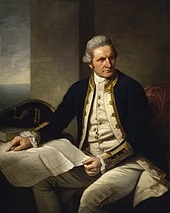 |
| Portrait of Captain
James Cook, the first European to map the
eastern coastline of Australia in 1770. |
Terra Australis
In the 1600s, Dutch merchants traded with the islands of
Batavia (now Indonesia), to the north of Australia and
several different Dutch ships touched on the coast of
Australia. The Dutch governor, van Diemen, sent Abel
Tasman on a voyage of discovery and he found Tasmania,
which he named Van Diemen's Land. Its name was later
changed to honour the man who discovered it.
The British Government was sure that there must be a
very large land in the south, that had not been
explored. They sent Captain James Cook to the Pacific
Ocean. His ship, HMS Endeavour, carried the famous
scientists, Sir Joseph Banks and Dr Solander who were
going to Tahiti where they would watch the planet Venus
pass in front of the Sun. Captain Cook's secret mission
was to find "Terra Australis" (the Land of the South).
The voyage of discovery was very successful, because
they found New Zealand and sailed right around it. Then
they sailed westward. At last, a boy, William Hicks, who
was up the mast spotted land on the horizon. Captain
Cook named that bit of land Point Hicks. They sailed up
the coast and Captain Cook named the land that he saw
"New South Wales". At last they sailed into a large open
bay which was full of fish and stingrays which the
sailors speared for food. Joseph Banks and Dr. Solander
went ashore and were astonished to find that they did
not know what any of the plants or birds or animals that
they saw were. They collected hundreds of plants to take
back to England.
Captain Cook saw the Aboriginal people with their simple
way of life. He saw them fishing and hunting and
collecting grass seeds and fruit. But there were no
houses and no fences. In most parts of the world, people
put up a house and a fence or some marker to show that
they own the land. But the Aboriginal people did not own
the land in that way. They belonged to the land, like a
baby belongs to its mother. Captain Cook went home to
England and told the government that no-one owned the
land. This would later cause a terrible problem for the
Aboriginal people. |
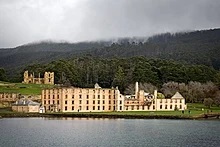 |
| Tasmania's Port
Arthur penal settlement is one of eleven UNESCO
World Heritage-listed Australian Convict Sites. |
Settlement
In the 1700s, in England, laws were tough, many people
were poor and gaols (jails) were full. A person could be
sentenced to death for stealing a loaf of bread. Many
people were hung for small crimes. But usually they were
just thrown in gaol. Often they were sent away to the
British colonies in America. But by the 1770s, the
colonies in America became the United States. They were
free from British rule and would not take England's
convicts any more, so England needed to find a new and
less populated place.
By the 1780s the gaols of England were so full that
convicts were often chained up in rotting old ships. The
government decided to make a settlement in New South
Wales and send some of the convicts there. In 1788 the
First Fleet of eleven ships set sail from Portsmouth
carrying convicts, sailors, marines, a few free settlers
and enough food to last for two years. Their leader was
Captain Arthur Phillip. They were to make a new colony
at the place that Captain Cook had discovered, named
Botany Bay because of all the unknown plants found there
by the two scientists.
Captain Phillip found that Botany Bay was flat and
windy. There was not much fresh water. He went with two
ships up the coast and sailed into a great harbor which
he said was "the finest harbor in the world!" There were
many small bays on the harbor so he decided on one which
had a good stream of fresh water and some flat shore to
land on. On 26 January 1788, the flag was raised and New
South Wales was claimed in the name of King George III
of England, and the new settlement was called Sydney.
For the first few years of the settlement, things were
very difficult. No-one in the British Government had
thought very hard about what sort of convicts should be
sent to make a new colony. Nobody had chosen them
carefully. There was only one man who was a farmer.
There was no-one among the convicts who was a builder, a
brick-maker or a blacksmith. No-one knew how to fix the
tools when they broke. All of the cattle escaped. There
were no cooking pots. All the plants were different so
no-one knew which ones could be eaten. It was probable
that everyone in the new colony would die of starvation.
Somehow, the little group of tents with a hut for the
Governor, Arthur Phillip, and another hut for the supply
of food, grew into a small town with streets, a bridge
over the stream, a windmill for grinding grain and
wharves for ships. By the 1820s there was a fine brick
house for the Governor. There was also a hospital and a
convict barracks and a beautiful church which are still
standing today. Settlements had spread out from Sydney,
firstly to Norfolk Island and to Van Diemen's Land
(Tasmania), and also up the coast to Newcastle, where
coal was discovered, and inland where the missing cattle
were found to have grown to a large herd. Spanish Merino
sheep had been brought to Sydney, and by 1820, farmers
were raising fat lambs for meat and also sending fine
wool back to the factories of England.
While the settlement was growing in New South Wales, it
was also growing in Tasmania. The climate in Tasmania
was more like that in England, and farmers found it easy
to grow crops there. |
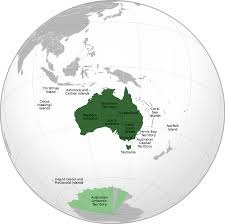 |
| A map of Australia's
states and territories. |
Exploration
Because Australia is such a very large land, it was easy
to think that it might be able to hold a very large
number of people. In the early days of the colony, a
great number of explorers went out, searching for good
land to settle on. When the settlers looked west from
Sydney, they saw a range of mountains which they called
the Blue Mountains. They were not very high and did not
look very rugged but for many years no-one could find
their way through them. In 1813 Gregory Blaxland,
William Lawson and a 17-year-old called William Charles
Wentworth crossed the Blue Mountains and found land on
the other side which was good for farming. A road was
built and the governor, Lachlan Macquarie founded the
town of Bathurst on the other side, 100 miles from
Sydney.
Some people, like Captain Charles Sturt were sure that
there must be a sea in the middle of Australia and set
out to find it. Many of the explorers did not prepare
very well, or else they went out to explore at the
hottest time of year. Some died like Burke and Wills.
Ludwig Leichhardt got lost twice. The second time, he
was never seen again. Major Thomas Mitchell was one of
the most successful explorers. He mapped the country as
he went, and his maps remained in use for more than 100
years. He travelled all the way to what is now western
Victoria, and to his surprise and annoyance found that
he was not the first white person there. The Henty
brothers had come from Tasmania, had built themselves a
house, had a successful farm and fed the Major and his
men on roast lamb and wine. |
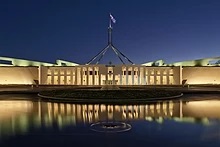 |
| Parliament House,
Canberra. |
Self government
The gold rushes of New South Wales and Victoria started
in 1851 leading to large numbers of people arriving to
search for gold. The population grew across south east
Australia and made great wealth and industry. By 1853
the gold rushes had made some poor people, very rich.
The transportation of convicts to Australia ended in the
1840s and 1850s and more changes came. The people in
Australia wanted to run their own country, and not be
told what to do from London. The first governments in
the colonies were run by governors chosen by London.
Soon the settlers wanted local government and more
democracy. William Wentworth started the Australian
Patriotic Association (Australia's first political
party) in 1835 to demand democratic government. In 1840,
the city councils started and some people could vote.
New South Wales Legislative Council had its first
elections in 1843, again with some limits on who could
vote. In 1855, limited self-government was given by
London to New South Wales, Victoria, South Australia and
Tasmania. In 1855, the right to vote was given to all
men over 21 in South Australia. The other colonies soon
followed. Women were given the vote in the Parliament of
South Australia in 1895 and they became the first women
in the world allowed to stand in elections.
Australians had started parliamentary democracies all
across the continent. But voices were getting louder for
all of them to come together as one country with a
national parliament.
The Commonwealth of
Australia
Until 1901, Australia was not a nation, it was six
separate colonies governed by Britain. They voted to
join together to form one new country, called the
Commonwealth of Australia, in 1901. Australia was still
part of the British Empire, and at first wanted only
British or Europeans to come to Australia. But soon it
had its own money, and its own Army and Navy.
In Australia at this time, the trade unions were very
strong, and they started a political party, the
Australian Labor Party. Australia passed many laws to
help the workers.
In 1914, the First World War started in Europe.
Australia joined in on the side of Britain against
Germany, Austria-Hungary and the Ottoman Empire.
Australian soldiers were sent to Gallipoli, in the
Ottoman Empire. They fought bravely, but were beaten by
the Turks. Today Australia remembers this battle every
year on ANZAC Day. They also fought on the Western
Front. More than 60,000 Australians were killed.
Australia had a really hard time in the Great Depression
of the 1930s and joined Britain in a war against Nazi
Germany when Hitler invaded Poland in 1939. But in 1941
lots of Australian soldiers were captured in the Fall of
Singapore by Japan. Then Japan started attacking
Australia and people worried about invasion. But with
help from the United States Navy, the Japanese were
stopped. After the war, Australia became a close friend
of the United States.
When the war ended, Australia felt that it needed many
more people to fill the country up and to work. So the
government said it would take in people from Europe who
had lost their homes in the war. It did things like
building the Snowy Mountains Scheme. Over the next 25
years, millions of people came to Australia. They came
especially from Italy and Greece, other countries in
Europe. Later they also came from countries like Turkey
and Lebanon. An important new party, the Liberal Party
of Australia was made by Robert Menzies in 1944 and it
won lots of elections from 1949 until in 1972, then
Gough Whitlam won for the Labor Party. Whitlam made
changes, but he made the Senate unhappy and the
Governor-General sacked him and forced an election in
1975. Then Malcolm Fraser won a few elections for the
Liberal Party.
In the 1960s many people began coming to Australia from
China, Vietnam, Malaysia and other countries in Asia.
Australia became more multicultural. In the 1950s and
1960s Australia became one of the richest countries in
the world, helped by mining and wool. Australia started
trading more with America, than Japan. Australia
supported the United States in wars against
dictatorships in Korea and Vietnam and later Iraq.
Australian soldiers also helped the United Nations in
countries like East Timor in 1999.
In 1973, the famous Sydney Opera House opened. In the
1970s, 80s and 90s lots of Australian movies, actors and
singers became famous around the world. In the year
2000, Sydney had the Summer Olympics.
In the 1980s and 90s, the Labor Party under Bob Hawke
and Paul Keating, then the Liberal Party under John
Howard made lots of changes to the economy. Australia
had a bad recession in 1991, but when other Western
countries had trouble with their economies in 2008,
Australia stayed strong.
Today Australia is a rich, peaceful and democratic
country. But it still has problems. Around 4-5% of
Australians could not get a job in 2010. A lot of land
in Australia (like Uluru) has been returned to
Aboriginal people, but lots of Aborigines are still
poorer than everybody else. Every year the government
chooses a big number of new people from all around the
world to come as immigrants to live in Australia. These
people may come because they want to do business, or to
live in a democracy, to join their family, or because
they are refugees. Australia took 6.5 million immigrants
in the 60 years after World War Two, including around
660,000 refugees.
Julia Gillard became the first woman Prime Minister of
Australia in 2010 when she replaced her colleague Kevin
Rudd of the Labor Party. |
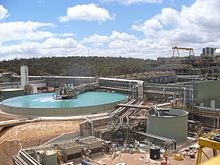 |
| The Boddington Gold
Mine in Western Australia is the nation's
largest open cut mine. |
Economy
Australia is a wealthy country; it generates its income
from various sources including mining-related exports,
telecommunications, banking and manufacturing.
The Australian dollar is the currency for the nation,
including Christmas Island, Cocos (Keeling) Islands, and
Norfolk Island, as well as the independent Pacific
Island states of Kiribati, Nauru, and Tuvalu.
All of Australia's major cities fare well in global
comparative livability surveys; Melbourne reached top
spot for the fourth year in a row on The Economist's
2014 list of the world's most liveable cities, followed
by Adelaide, Sydney, and Perth in the fifth, seventh,
and ninth places respectively.
The service sector of the economy, including tourism,
education, and financial services, accounts for about
70% of GDP.
Rich in natural resources, Australia is a major exporter
of agricultural products, particularly wheat and wool,
minerals such as iron-ore and gold, and energy in the
forms of liquified natural gas and coal. Although
agriculture and natural resources account for only 3%
and 5% of GDP respectively, they contribute
substantially to export performance.
Australia's largest export markets are Japan, China, the
US, South Korea, and New Zealand.
Australia is the world's fourth largest exporter of
wine, and the wine industry contributes A$5.5 billion
per year to the nation's economy. |
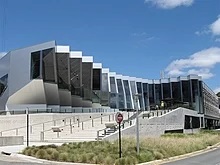 |
| Five Australian
universities rank in the top 50 of the QS World
University Rankings, including the Australian
National University (19th). |
Demography
Until the Second World War, the vast majority of
settlers and immigrants came from the British Isles, and
a majority of Australians have some British or Irish
ancestry. These Australians form an ethnic group known
as Anglo-Celtic Australians. In the 2016 Australian
census, the most commonly nominated ancestries were
English (36.1%), Australian (33.5%), Irish (11.0%),
Scottish (9.3%), Chinese (5.6%), Italian (4.6%), German
(4.5%), Indian (2.8%), Greek (1.8%), and Dutch (1.6%).
Australia's population has quadrupled since the end of
World War I, much of this increase from immigration.
Following World War II and through to 2000, almost 5.9
million new immigrants arrived and settled in the
country. Most immigrants are skilled, but the
immigration quota includes categories for family members
and refugees. By 2050, Australia's population is
currently projected to reach around 42 million.
Nevertheless, its population density, 2.8 inhabitants
per square kilometre, remains among the lowest in the
world.
In 2016, more than a quarter (26%) of Australia's
population were born overseas; the five largest
immigrant groups were those born in England (3.9%), New
Zealand (2.2%), Mainland China (2.2%), India (1.9%), and
the Philippines (1%). Following the abolition of the
White Australia policy in 1973, numerous government
initiatives have been established to encourage and
promote racial harmony based on a policy of
multiculturalism. In 2015–16, there were 189,770
permanent immigrants admitted to Australia, mainly from
Asia.
The Indigenous population—Aborigines and Torres Strait
Islanders—was counted at 649,171 (2.8% of the total
population) in 2016.
Politics
Australia is made up of six states and three mainland
territories. Each state and territory has its own
Parliament and makes its own local laws. The Parliament
of Australia sits in Canberra and makes laws for the
whole country, also known as the Commonwealth or
Federation.
The Federal government is led by the Prime Minister of
Australia, who is the member of Parliament chosen as
leader. The current Prime Minister is Scott Morrison.
The leader of Australia is the Prime Minister, although
the Governor-General represents the Queen of Australia,
who is also the Queen of Great Britain, as head of
state. The Governor-General, currently David Hurley, is
chosen by the Prime Minister. |
|
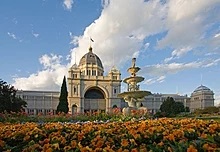 |
| The Royal Exhibition
Building in Melbourne was the first building in
Australia to be listed as a UNESCO World
Heritage Site in 2004. |
Culture
Australia was colonised by people from Britain, but
today people from all over the world live there. English
is the main spoken language, and Christianity is the
main religion, though all religions are accepted and not
everybody has a religion. Australia is multicultural,
which means that all its people are encouraged to keep
their different languages, religions and ways of life,
while also learning English and joining in with other
Australians.
Famous Australian writers include the bush balladeers
Banjo Paterson and Henry Lawson who wrote about life in
the Australian bush. More modern famous writers include
Peter Carey, Thomas Keneally and Colleen McCullough. In
1973, Patrick White won the Nobel Prize in Literature,
the only Australian to have achieved this; he is seen as
one of the great English-language writers of the
twentieth century.
Australian music has had lots of world-wide stars, for
example the opera singers Nellie Melba and Joan
Sutherland, the rock and roll bands Bee Gees, AC/DC and
INXS, the folk-rocker Paul Kelly (musician), the pop
singer Kylie Minogue and Australian country music stars
Slim Dusty and John Williamson. Australian Aboriginal
music is very special and very ancient: it has the
famous digeridoo woodwind instrument.
Australian TV has produced many successful programs for
home and overseas - including Skippy the Bush Kangaroo,
Home and Away and Neighbours - and produced such well
known TV stars as Barry Humphries (Dame Edna Everage),
Steve Irwin (The Crocodile Hunter) and The Wiggles.
Major Australian subgroups such as the Bogan have been
shown on Australian TV in shows such as Bogan Hunters
and Kath & Kim.
Australian movies have a very long history. The world's
first feature movie was the Australian movie The Story
of the Kelly Gang of 1906. In 1933, In the Wake of the
Bounty, directed by Charles Chauvel, had Errol Flynn as
the main actor. Flynn went on to a celebrated career in
Hollywood. The first Australian Oscar was won by 1942's
Kokoda Front Line!, directed by Ken G. Hall. In the
1970s and 1980s lots of big Australian movies and movie
stars became world famous with movies like Picnic at
Hanging Rock, Gallipoli (with Mel Gibson), The Man From
Snowy River and Crocodile Dundee. Russell Crowe, Cate
Blanchett and Heath Ledger became global stars during
the 1990s and Australia starring Nicole Kidman and Hugh
Jackman made a lot of money in 2008. |
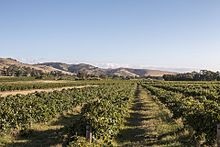 |
| A vineyard in the
Barossa Valley, one of Australia's major
wine-producing regions. The Australian wine
industry is the world's fourth largest exporter
of wine. |
Cuisine
Most Indigenous Australian tribal groups subsisted on a
simple hunter-gatherer diet of native fauna and flora,
otherwise called bush tucker. The first settlers
introduced British food to the continent, much of which
is now considered typical Australian food, such as the
Sunday roast. Multicultural immigration transformed
Australian cuisine; post-World War II European migrants,
particularly from the Mediterranean, helped to build a
thriving Australian coffee culture, and the influence of
Asian cultures has led to Australian variants of their
staple foods, such as the Chinese-inspired dim sim and
Chiko Roll. Vegemite, pavlova, lamingtons and meat pies
are regarded as iconic Australian foods. Australian wine
is produced mainly in the southern, cooler parts of the
country.
Australia is also known for its cafe and coffee culture
in urban centres, which has influenced coffee culture
abroad, including New York City. Australia and New
Zealand were responsible for the flat white coffee. |
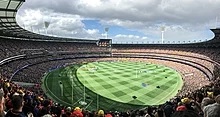 |
| The Melbourne
Cricket Ground is strongly associated with the
history and development of cricket and
Australian rules football, Australia's two most
popular spectator sports. |
Sport
Sport is an important part of Australian culture because
the climate is good for outdoor activities. 23.5%
Australians over the age of 15 regularly take part in
organised sporting activities. In international sports,
Australia has very strong teams in cricket, hockey,
netball, rugby league and rugby union, and performs well
in cycling, rowing and swimming. Local popular sports
include Australian Rules Football, horse racing, soccer
and motor racing. Australia has participated in every
summer Olympic Games since 1896, and every Commonwealth
Games. Australia has hosted the 1956 and 2000 Summer
Olympics, and has ranked in the top five medal-winners
since 2000. Australia has also hosted the 1938, 1962,
1982 and 2006 Commonwealth Games and are to host the
2018 Commonwealth Games. Other major international
events held regularly in Australia include the
Australian Open, one of the four Grand Slam tennis
tournaments, annual international cricket matches and
the Formula One Australian Grand Prix. Corporate and
government sponsorship of many sports and elite athletes
is common in Australia. Televised sport is popular; some
of the highest-rated television programs include the
Summer Olympic Games and the grand finals of local and
international football competitions.
The main sporting leagues for males are the Australian
Football League, National Rugby League, A-League and
NBL. For women, they are ANZ Netball Championships,
W-League and WNBL.
Famous Australian sports players include the cricketer
Sir Donald Bradman, the swimmer Ian Thorpe and the
athlete Cathy Freeman.
Art festivals
Just 60 years ago, Australia had only one big art
festival. Now Australia has hundreds of smaller
community-based festivals, and national and regional
festivals that focus on specific art forms. |
|
 Kiddle: Australia Kiddle: Australia
Wikipedia: Australia |
|
|
|
|
|
|
|
|
|
|
|
|
|
|
|
|
Search Fun Easy English |
|
|
|
|
|
|
|
|
|
|
|
|
|
|
|
About
Contact
Copyright
Resources
Site Map |